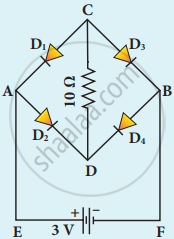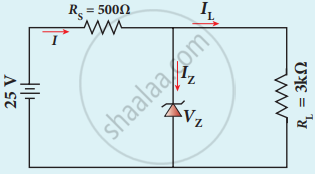Advertisements
Advertisements
प्रश्न
Four silicon diodes and a 10 Ω resistor are connected as shown in the figure below. Each diode has a resistance of 1 Ω. Find the current flows through the 10 Ω resistor.

उत्तर
Current flow through D1 and D3 = 2 Ω
Current flow through D2 and D4 = 2 Ω
These two are in parallel so
Net resistants = `1/2 + 1/2` = 1 Ω
Total Resistance = 1 Ω + 18 Ω = 19 Ω
V = 2.5 Ω
I = `"V"/"R" = 2.5/19`
I = 0.13 A
APPEARS IN
संबंधित प्रश्न
The barrier potential of a silicon diode is approximately, ____________.
In an unbiased p-n junction, the majority of charge carriers (that is, holes) in the p-region diffuse into the n-region because of
If a positive half-wave rectified voltage is fed to a load resistor, for which part of a cycle there will be current flow through the load?
Which one of the following represents forward bias diode?
A diode is called a unidirectional device. Explain.
What do you mean by leakage current in a diode?
Mention the types of biasing.
Draw the circuit diagram of a half wave rectifier and explain its working.
Explain the formation of depletion region and barrier potential in PN junction diode.
In the given figure of a voltage regulator, a Zener diode of breakdown voltage 10 V is employed. Determine the current through the load resistance, the total current and the current through the diode. Use diode approximation.

